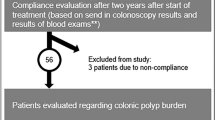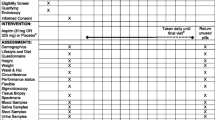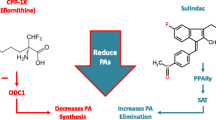Abstract
Recent evidence suggests that nonsteroidalantiinflammatory drugs (NSAIDs) may prevent colorectalcancer. The mechanism of action of NSAIDs inchemoprevention is unknown but may be linked to theireffect on mucosal prostaglandin levels. Levels of fivemajor prostaglandin metabolites were measured by gaschromatography-mass spectrometry in biopsy specimens offlat rectal mucosa from four patients with familial adenomatous polyposis (FAP) before and aftersulindac therapy and from five healthy individuals. Theprostaglandin present at highest concentration in rectalmucosa from FAP and control subjects was prostaglandin E2. The concentration of thromboxaneB2 alone was significantly elevated in FAPpatients compared to controls (P = 0.016). In FAPpatients treated with sulindac, all prostaglandinmetabolite levels were significantly reduced compared to pretreatmentlevels (P < 0.05) except prostaglandin D2(P = 0.07). Prostaglandins D2, E2,F2α, and 6-keto-F1αlevels also were significantly reduced in FAP patients on sulindac compared to healthy controls (P< 0.05). However, interpatient heterogeneity ofresponse to sulindac was evident with changes rangingfrom +19% to –89%, and the patient with thegreatest reductions after sulindac developed colorectal cancerafter 35 months of therapy. Sulindac treatment, at drugdoses shown to regress colorectal adenomas in FAPpatients, has heterogeneous effects on the level ofmajor prostaglandins in their rectal mucosa and maynot prevent colorectal cancer due to uncoupling ofprostaglandin levels and carcinogenesis.
Similar content being viewed by others
REFERENCES
Giardiello FM, Offerhaus GJA, DuBois RN: Role of nonsteroidal drugs in colon cancer prevention. Eur J Cancer 31A: 1071- 1076, 1995
Hial V, Demello MC, Horakova Z, Beaven MA: Antiproliferative activity of antiinflammatory drugs in two mammalian cell culture cell lines. J Pharmacol Exp Ther 202: 446 - 454, 1977
Bayer BM, Beaven MA: Evidence that indomethacin reversibly inhibits cell growth in the G1 phase of the cell cycle. Biochem Pharmacol 28: 441- 443, 1979
Bayer BM, Kruth HS, Vaughan M, Beaven MA: Arrest of cultured cells in the G1 phase of the cell cycle by indomethacin. Pharmacol Exp Ther 210: 106 - 111, 1979
Pollard M, Luckert PH: Indomethacin treatment of rats with dime thylhydrazine-induced intestinal tumors. Cancer Treat Rep 64: 1323- 1327, 1980
Moorghen M, Ince P, Finney KJ, Sunter JP, Appleton DR, Watson AJ: A protective effect of sulindac against chemically-induced primary colonic tumors in mice. J Pathol 156: 341- 347, 1988
Skinner SA, Penny AG, O'Brien PE: Sulindac inhibits the rate of growth and development of colon tumors in the rat. Gastroenterology 100: A403, 1990
Reddy BS, Rao CV, Rivenson A, Kelloff G: Inhibitory effect of aspirin on azoxymethane-induced colon carcinogenesis in F344 rats. Carcinogenesis 14: 1493- 1497, 1993
Jacoby RF, Marshall, Newton MA, Novakovic K, Tutsch K, Cole CE, Lubet RA, Kellof GH, Verma A, Moser AR, Dove WF: Chemoprevention of spontaneous intestinal adenomas in APC Min mouse mode l by the nonsteroidal antiinflammatory drug piroxicam. Cancer Res 56: 710 - 715, 1996
Thun M, Namboodiri M, Heath C: Aspirin use and reduced risk of fatal colon cancer. N Engl J Med 325: 1593- 1596, 1991
Giovannucci E, Rimm EB, Stampfer MJ, Colditz GA, Ascherio A, Willett WC: Aspirin use and risk for colorectal cancer and adenoma in male health professionals. Ann Intern Med 121: 241- 246, 1994
Waddell WR, Loughry RW: Sulindac for polyposis of the colon. J Surg Oncol 24: 83- 87, 1983
Rigau J, Pique JM, Rubio E, Planas R, Tarrech JM, Bordas J: Effects of long-term sulindac therapy on colonic polyposis. Ann Intern Med 115: 952- 954, 1991
Labayle D, Fischer D, Vielh P, Drouhin F, Pariente A, Bories C, Duhamel O, Trousset M, Attali P: Sulindac causes regression of rectal polyps in familial adenomatous polyposis. Gastroenterology 101: 635- 639, 1991
Giardiello FM, Hamilton SR, Krush AJ, Piantadosi S, Hylind LM, Celano P, Booker SV, Robinson CR, Offerhaus GJA: Treatment of colonic and rectal adenomas with sulindac in familial adenomatous polyposis. N Engl J Med 398: 1313- 1316, 1993
Nugent KP, Farmer KCR, Spigelman AD, Williams DB, Phillips RKS: Randomized controlled clinical trial of sulindac on intestinal polyposis in FAP. Br J Surg 80: 1618 - 1619, 1993
Honn KV, Bockmann RS, Marnett LJ: Prostaglandin and cancer a review of tumor initiation through tumor metastasis. Prostaglandin 21: 833- 864, 1981
Jaffe BM: Prostaglandin and cancer: An update. Prostaglandin 6: 453- 461, 1974
Nariswa T, Kusaka H, Yamazaki Y, Takahashi M, Koyama H, Koyama K, et al: Relationship between blood plasma prostaglandin E2 and liver lung metastase s in colorectal cancer. Dis Colon Rectum 33: 840 - 845, 1990
Jaffe BM, Parker CW, Philpott GW: Immunochemical measurement of prostaglandin or prostaglandin-like activity from normal and neoplastic cultured tissue. Surg Forum 22: 90 - 92, 1971
Bennett A, Del Tacca M, Stamford IF, Zebro T: Prostaglandin from tumours of human large bowel. Br J Cancer 35: 881- 884, 1977
Tanka M, Nazkazawa S, Koike M: Investigation of endogenous prostaglandin in DMH-induced colonic cancer in rats. J Gastroenterol 82: 592- 598, 1985
Yamaguchi A, Ishida T, Nishimura G, Katoh M, Miyazaki I: Investigation of colonic prostaglandin in carcinogenesis in the rat colon. Dis Colon Rectum 34: 572- 576, 1991
Pugh S, Thomas GAO: Patients with adenomatous polyps and carcinomas have increase d colonic mucosal prostaglandin E2. Gut 35: 675- 678, 1994
Earnest DL, Hixson LJ, Finley PR, Backwell GG, Einspahr J, Emerson SS, Alberts DS: Arachidonic acid cascade inhibitors in chemoprevention of human colonic cancer: Pre liminary studies. InCancer Chemoprevention. L Wattenberg, M Lipkin, CW Boone, GJ Kelloff (eds). Boca Raton, Florida, CRC Press, 1992, pp 165- 180
Ahnen D, Alberts D, Hixson L, Paranka N, Burt R, Panukcu R: The sulfone metabolite of sulindac (FGN-1) inhibits rat colonic carcinogenesis but does not inhibit either prostaglandin synthesis or colonic proliferation. Gastroenterology 108: A444, 1995
Hanif R, Pittas A, Feng Y, Koutsos M, Shiff S, Staiano-Coico L, Rigas B: NSAIDs inhibit the growth of colon cancer cell lines by a prostaglandin independent pathway. Gastroenterology 108: A478, 1995
Winde G, Schmid KW, Schlegel W, Fischer R, Osswald H, Bunte H: Complete reversion and prevention of rectal adenomas in colectomized patients with familial adenomatous polyposis by rectal low-dose sulindac maintenance treatment. Dis Colon Rectum 38: 813- 830, 1995
Nugent KP, Spigelman AD, Phillips RKS: Tissue prostaglandin levels in familial adenomatous polyposis patients treated with sulindac. Dis Colon Rectum 659 - 662, 1996
Hubbard WC, Litterst CL, Liu MC, Bleecker ER, Eggleston JC, McLemore TL, Boyd MR: Profiling of prostaglandin biosynthesis in biopsy fragments of human lung carcinoma and human lung tissues by capillary gas chromatography- negative ion chemical ionization mass spectrometry. Prostaglandins 32: 889 - 906, 1986
Liu MC, Bleecker ER, Proud D, Mclemore TL, Hubbard WC: Profiling of bisenoic prostaglandins and thromboxane B2 in bronchoalveolar fluid from the lower respiratory tract of human subjects by combined capillary gas chromatography- mass spectrometry. Prostaglandins 35: 69 - 81, 1988
Finley PR, Bogert CL, Alberts DS, Einspahr J, Earnest DL, Blackwell G, Girodias K: Measurement of prostaglandin E2 in rectal mucosa in human subjects: A method study. Cancer Epidemiol Biomarkers Prev 4: 239 - 244, 1995
Thorson AG, Lynch HT, Smyrk TC: Rectal cancer in FAP patient after sulindac. Lancet 343; 180, 1994
Niv Y, Fraser GM: Adenocarcinoma in the rectal segment in familial polyposis coli is not prevented by sulindac therapy. Gastroenterology 107: 854 - 857, 1994
Pasricha PJ, Bedi A, O'Connor K, Rashid A, Akhtar AJ, Zahurak ML, Piantadosi S, Hamilton SR, Giardiello FM: The effects of sulindac on colorectal proliferation and apoptosis in familial adenomatous polyposis. Gastroenterology 109: 994 - 998, 1996
Piazza GA, Alberts DS, Hixson LJ, Paranka NS, Li H, Finn T, Bogert C, Guillen JM, Brendel K, Gross PH, Sperl G, Ritchie J, Burt RW, Ellsworth L, Ahnen DJ, Pamukeu R: Sulindac sulfone inhibits azoxymethane-induced colon carcinogenesis in rats without reducing prostaglandin levels. Cancer Res 57: 2909 - 2915, 1997
Thompson HJ, Jiang C, Lu JX, Menta RG, Piazza GA, Paranka NS, Panukcu R, Ahnen DJ: Sulfone metabolite of sulindac inhibits Mammary carcinogenesis. Cancer Rese arch 57: 267- 271, 1997
Rights and permissions
About this article
Cite this article
Dubois, R.N., Hylind, L.M., Robinson, C.R. et al. Prostaglandin Levels in Human Colorectal Mucosa (Effects of Sulindac in Patients with Familial Adenomatous Polyposis). Dig Dis Sci 43, 311–316 (1998). https://doi.org/10.1023/A:1018898120673
Issue Date:
DOI: https://doi.org/10.1023/A:1018898120673




